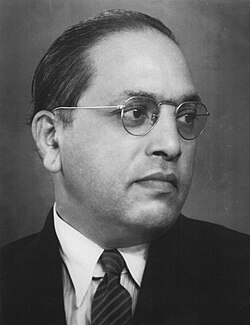
Back النظام الطبقي في الهند Arabic ভারতে বর্ণপ্রথা Bengali/Bangla Kastovní systém v Indii Czech Y drefn gastiau yn India Welsh Σύστημα καστών της Ινδίας Greek Indiako kasta sistema Basque سیستم کاست در هند Persian Intian kastilaitos Finnish Castes en Inde French વર્ણવ્યવસ્થા Gujarati

The caste system in India is the paradigmatic ethnographic instance of social classification based on castes. It has its origins in ancient India, and was transformed by various ruling elites in medieval, early-modern, and modern India, especially in the aftermath of the collapse of the Mughal Empire and the establishment of the British Raj.[1][2][3][4]
Beginning in ancient India, the caste system was originally centered around varna, with Brahmins (priests) and, to a lesser extent, Kshatriyas (rulers and warriors) serving as the elite classes, followed by Vaishyas (traders, merchants, and farmers) and finally Shudras (labourers). Outside of this system are the oppressed, marginalised, and persecuted Dalits (also known as "Untouchables") and Adivasis (tribals).[5][6] Over time, the system became increasingly rigid, and the emergence of jati led to further entrenchment, introducing thousands of new castes and sub-castes.[7] With the arrival of Islamic rule, caste distinctions formulated in Muslim communities, across the subcontinent, as well.[1][8][9] The British Raj furthered the system, through census classifications and preferential treatment to Christians and people belonging to certain castes.[8] Social unrest during the 1920s led to a change in this policy towards affirmative action.[10][11][12] Today, there are around 3,000 castes and 25,000 sub-castes in India.[13]
Caste-based differences have also been practised in other regions and religions in the Indian subcontinent, like Nepalese Buddhism,[14] Christianity, Islam, Judaism and Sikhism.[15] It has been challenged by many reformist Hindu movements,[16] Buddhism, Sikhism, Christianity,[15] and present-day Neo Buddhism.[17] With Indian influences, the caste system is also practiced in Bali.[18]
After achieving independence in 1947, India banned discrimination on the basis of caste and enacted many affirmative action policies for the upliftment of historically marginalised groups as enforced through its constitution.[19] However, the system continues to be practiced in India, and caste-based discrimination, segregation, violence, and inequality persist.[20]
- ^ a b de Zwart (2000).
- ^ Bayly (2001), pp. 25–27, 392.
- ^ St. John (2012), p. 103.
- ^ Sathaye (2015), p. 214.
- ^ Cite error: The named reference
:2was invoked but never defined (see the help page). - ^ Bayly (2001), p. 9.
- ^ Basham, Wonder that was India (1954), p. 148.
- ^ a b Bayly (2001), p. 392.
- ^ Bayly (2001), pp. 26–27:What happened in the initial phase of this two-stage sequence was the rise of the royal man of prowess. In this period, both kings and the priests and ascetics with whom men of power were able to associate their rule became a growing focus for the affirmation of a martial and regal form of caste ideal. (...) The other key feature of this period was the reshaping of many apparently casteless forms of devotional faith in a direction which further affirmed these differentiations of rank and community.
- ^ Nehru, Jawaharlal (2004). The discovery of India. New Delhi: Penguin Books. ISBN 0-670-05801-7. OCLC 57764885.
- ^ Dirks (2001b), pp. 215–229.
- ^ Guha, Sumit. "The Birth of Caste". Beyond Caste. Permanent Black. pp. 38–39. ISBN 978-81-7824-513-3.
- ^ "What is India's caste system?". BBC News. 19 June 2019.
- ^ LeVine, Sarah (2009). Rebuilding Buddhism: The Theravada Movement in Twentieth-Century Nepal. Harvard University Press. p. 21. ISBN 978-0-674-02554-7.
- ^ a b Cohen (2001), p. 21.
- ^ Dirks (2001a), p. 3.
- ^ Omvedt, Gail (2014). Buddhism in India: Challenging Brahmanism and Caste. Sage Classics. p. 252. ISBN 978-81-321-1028-6.
- ^ Geoffrey Robinson (1995). The Dark Side of Paradise: Political Violence in Bali. Cornell University Press. p. 32. ISBN 0-8014-8172-4.
- ^ "What is India's caste system?". BBC News. 25 February 2016. Retrieved 27 May 2017.
Independent India's constitution banned discrimination on the basis of caste, and, in an attempt to correct historical injustices and provide a level playing field to the traditionally disadvantaged, the authorities announced quotas in government jobs and educational institutions for scheduled castes and tribes, the lowest in the caste hierarchy, in 1950.
- ^ Taylor, Sarah (27 June 2022). "'I would tell the other girls at school that I was Brahmin': The struggle to challenge India's caste system". ABC News.